Free Estimate Template Forms – An estimate is a form used to help define the parameters of a project. For example, if you hire a contractor without written agreement between you and the contractor, you will need proof about what you and the contractor have agreed. Both of you and the contractor will be aggrieved. You and the contractor will receive advantages with the template if it goes to court.
If you are familiar with the contractor, you can make the estimate or an agreement between the two of you casual and relaxed. You may even discuss the agreement during your conversation. Agreeing is also important to avoid any issues in the future if you and the contractor have different opinions.
This article will discuss explanations of the estimate, the purpose of the estimate, the components of the form, when to use it, why to use it, free estimate template forms, the differences from a formal contract, and the process of filling out.
The Purpose of the Estimate
The form’s purpose is to set and define the expectations and have them in black and white. This project template will help both of you should questions arise in the future about the job. Although the form takes minutes to use, this form will protect your interests as well as the contractor’s interests. This form can also prevent you and the contractor from going to court.
The Components of the estimate template
When planning a project that requires the services of a contractor, using an estimate template can be extremely beneficial. Not all estimate templates are created equal.
Below, we break down the essential components every estimate template should have.
- The Contract Essentials
This section should establish the names and addresses of all parties involved. Furthermore, it should elucidate the project’s scope in an executive summary.
- Time Completion
Here, you determine the estimated time to complete the project. It sets expectations and has implications for costs and project planning.
- Contractor Contact Information
It is where you list all the ways you can contact the contractor. Include phone numbers, email addresses, and even social media if applicable. It ensures you have a way to reach the contractor in various situations.
- Contractor’s License Information
The contractor’s license number and the jurisdiction where the license is valid should be included. It offers assurance regarding the contractor’s legitimacy and qualification to complete the job.
- Insurance
Details of the contractor’s liability insurance should be listed here. It is crucial for any accidents or damage during the project.
- The Scope of the Contractor’s Project
Clearly outline what the project involves from start to finish. This section will form the basis of what the contractor anticipates and can save you from unexpected costs.
- The Project Timing
It is more detailed than “Time Completion” and might include milestones, phases, and expected completion dates.
- The Exclusions
Detail what is not included in the estimate. For instance, if the contractor is not responsible for post-project clean-up, it should be stated here.
- Contractor’s Certifications
If the project requires specialized skills or certifications, they should be listed in this section. It provides extra assurance of the contractor’s competency.
- The Project Payment
It outlines how the contractor will be paid. It should specify the amount, payment milestones, acceptable forms of payment, and any late fees.
- Guarantees, Warranties, and Other Promises
Include any guarantees or warranties for the work to be performed.
- Totals
This section should comprehensively list all costs, including taxes or service fees.
- Total Inclusions
In contrast to the “Exclusions” section, this part lists everything included in the estimate. It could be materials, labor, and other miscellaneous items.
When to Use the Estimate Template
You should use the estimate template for property owners who plan to hire a contractor. The form will allow the contractor to define what the contractor wants to do for the client. The form should be used for:
- Appliance installation
- Appliance Repair
- Cabinetry installation
- Carpentry requests
- Carpet installation
- Driveway payment
- Flooring installs
- Indoor/Outdoor Painting
- Mold removal
- New home construction
- Old home renovation
- Plumbing installation and repairs
- Roof Repair
- Room remodeling project
- Underground plumbing repairs and more! project
Why Use an Estimate Template
An Estimate Template is a paper that helps you and the person you work with. It is really useful. Here’s why:
Easy to Talk
This paper helps everyone understand the job. It makes talking about the project easy.
Keeps You Safe
If there is a problem, this paper shows what everyone agreed to. It keeps you safe.
Very Clear
This paper tells you about the job, how long it will take, and how much it will cost. Everyone can see what is happening.
Saves Time
Because the paper has all the details, you don’t need to talk repeatedly. It lets everyone start working faster.
Helps with Money
The paper tells you how much the job will cost. It helps you know how much money you will spend or get.
Makes Sure Everyone Does Their Job
The paper says what needs to be done. So, everyone knows what it has to do.
Can Be Used for Many Jobs
You can use this paper for different kinds of work. It is not just for one thing.
Helps You Stay Organized
All the job details are in one paper. It helps everyone stay on track.
Makes You Look Good
Using a good paper like this makes people trust you more.
So, an Estimate Template is really good to use. It helps you and the person you’re working with to do a better job.
Free Estimate Template Forms
Free estimate template forms are not just one size fits all. You can find many kinds, each for a different job or project. Here are some:
Renovation Estimate Template
This form helps you if you’re fixing up a building or a room. It informs you how much you’ll pay to make something look new again.
Remodeling Estimate Template
This one is for changing the way a space looks or works. If you want to move a wall or add a new room, use this template.
Flooring Estimate Template
This form is for you if you need to put in new floors. It includes all the costs, from the wood to the labor.
Contractor Estimate Template
It is for general work done by a contractor. It can be used for many types of jobs, large or small.
Job Estimate Template
This form is appropriate for all types of jobs. It’s a very flexible form that fits many needs.
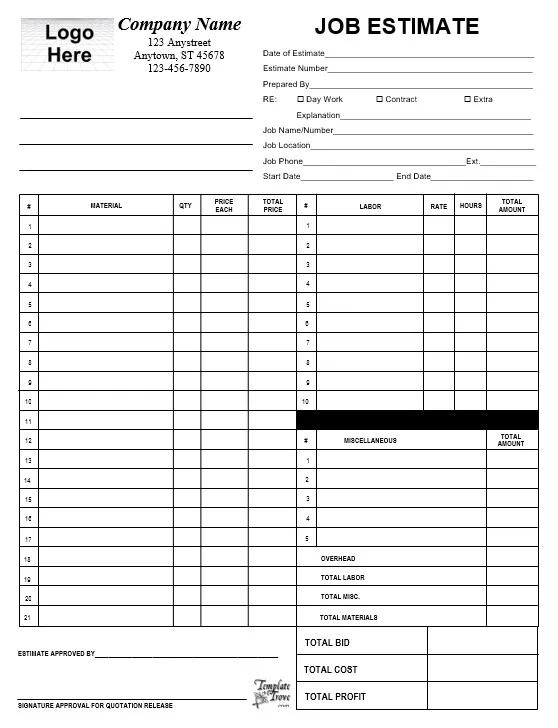
Auto Repair Estimate Template
This form is for car fixes. It shows all the parts and work needed to fix a car.
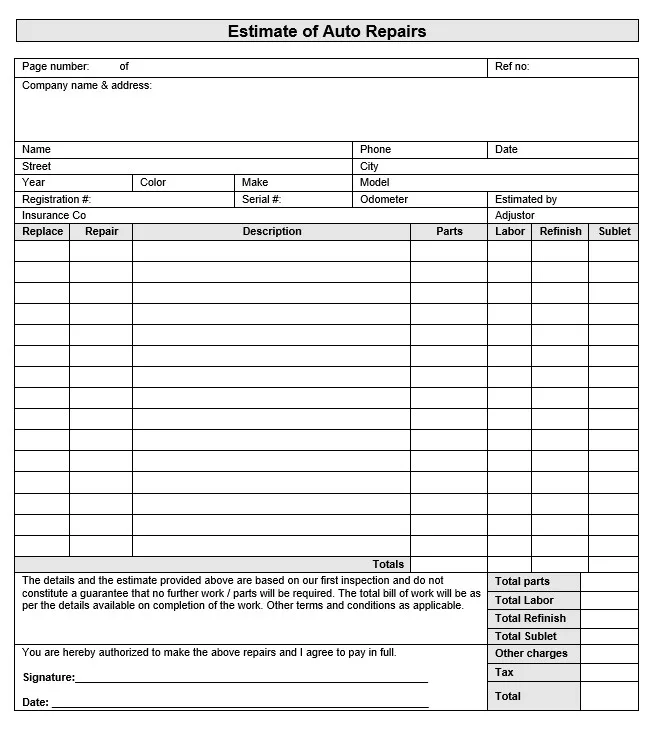
Photography Estimate Template
If you’re a photographer, this document helps you and your customer comprehend the prices of a photo shoot.
Gutter Estimate Template
If you need to fix or put in new gutters, this form will help. It lists all the tasks and costs.
Electrical Estimate Template
Use this if you need electrical work. It displays all that must be accomplished and how much it will cost.
Graphic Design Estimate Template
For graphic design jobs, this form is perfect. It talks about the design work and the costs.
Construction Estimate Template
Building something big? This form is for you. It includes all the big and little tasks in a construction project.
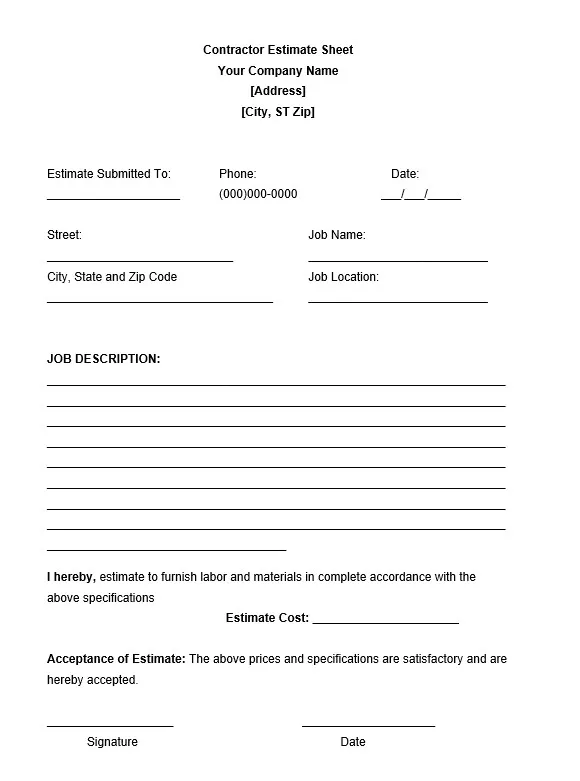
Moving Estimate Template
Moving homes or offices? This template will allow you to determine how much moving will cost.
Concrete Estimate Template
Need concrete work? This form shows you all the costs.
HVAC Estimate Template
For heating and cooling work, use this form. It covers all the tasks needed to keep a place warm or cool.
Roofing Estimate Template
This form helps if you need a new roof or repairs. It shows all the tasks and costs.
Repair Estimate Template
For general repairs around the home or office, this form is useful. It shows the needed fixes and how much they will cost.
Demolition Estimate Template
Need to tear something down? This form will list all the tasks and costs for that.
Project Estimate Template
It is a general form for any project you have. It helps you list all the steps and how much they will cost.
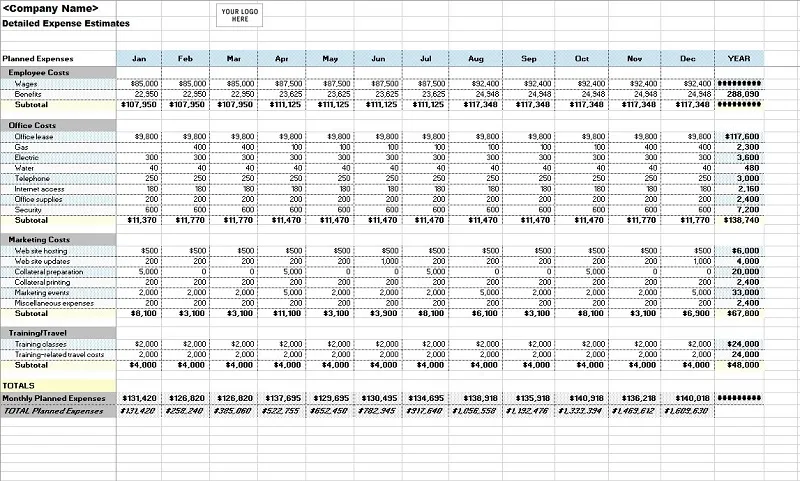
Carpentry Estimate Template
If you need woodwork, this form is for you. It includes all the costs of making things out of wood.
Cleaning Estimate Template
This form helps you comprehend how much cleaning a room, like a house or office, will cost.
Handyman Estimate Template
For smaller jobs around the house, this form is perfect. It’s for tasks that don’t need a specialist.
Painting Estimate Template
Need to paint? This form shows all the steps and costs for a painting job.
Home Repair Estimate
This form is for all kinds of fixes in a home. It describes what must be completed and how much it will cost.
Plumbing Estimate Template
For water and pipework, use this form. It will show you all the tasks and their costs.
Each form is a suitable form template for making your project go smoothly. Select the one that suits your requirements the best.
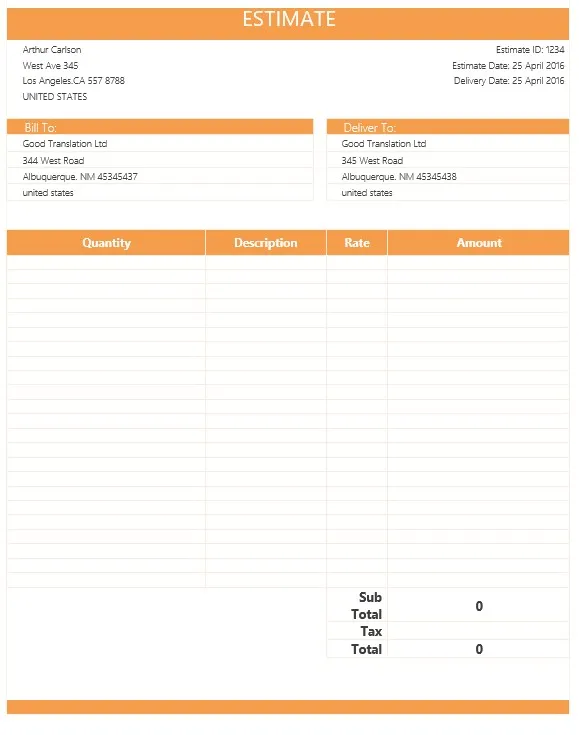
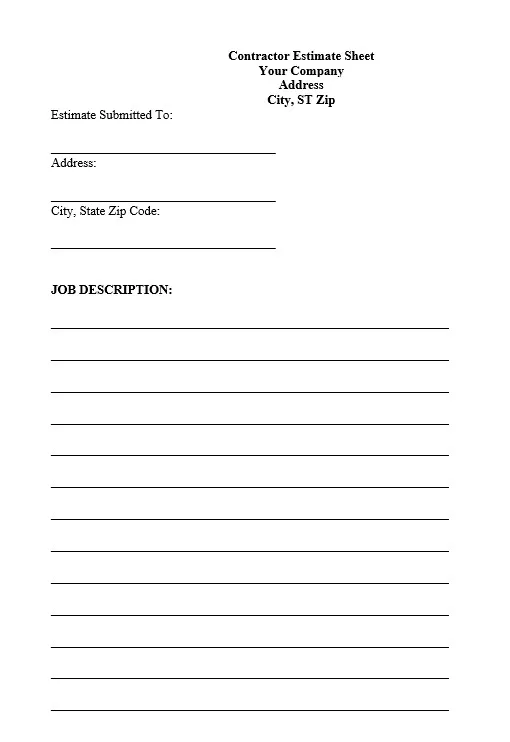
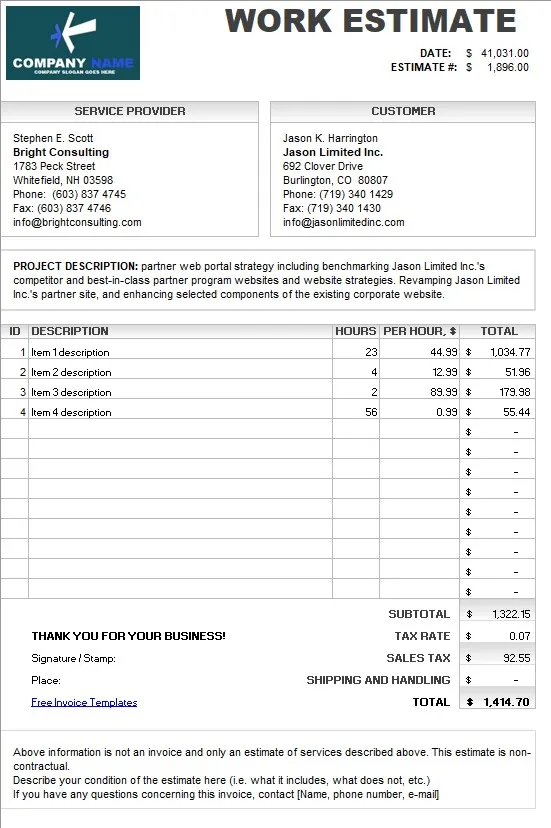
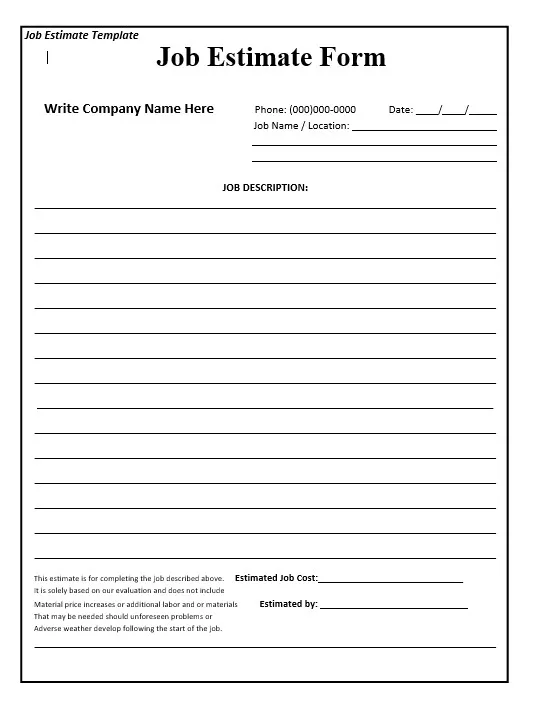
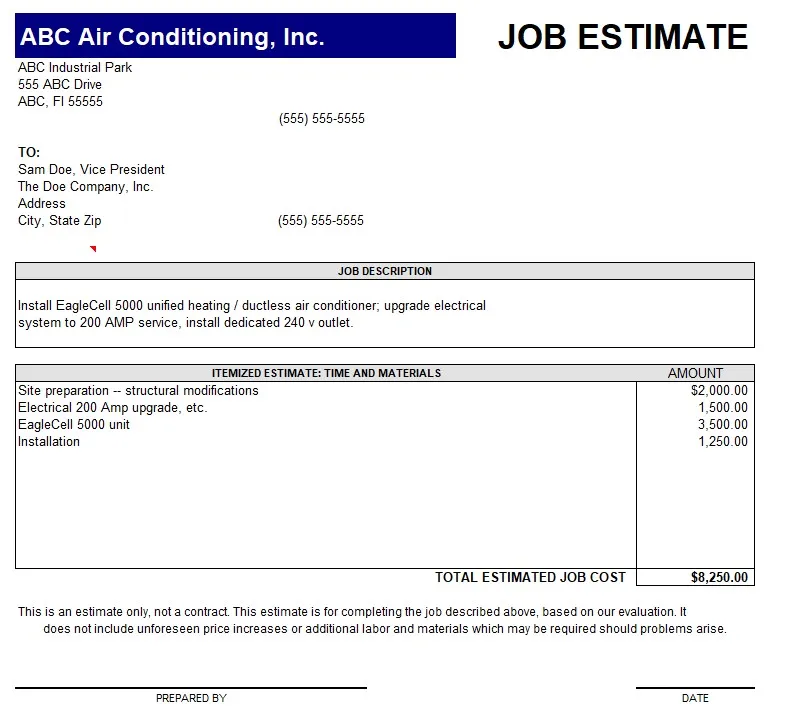
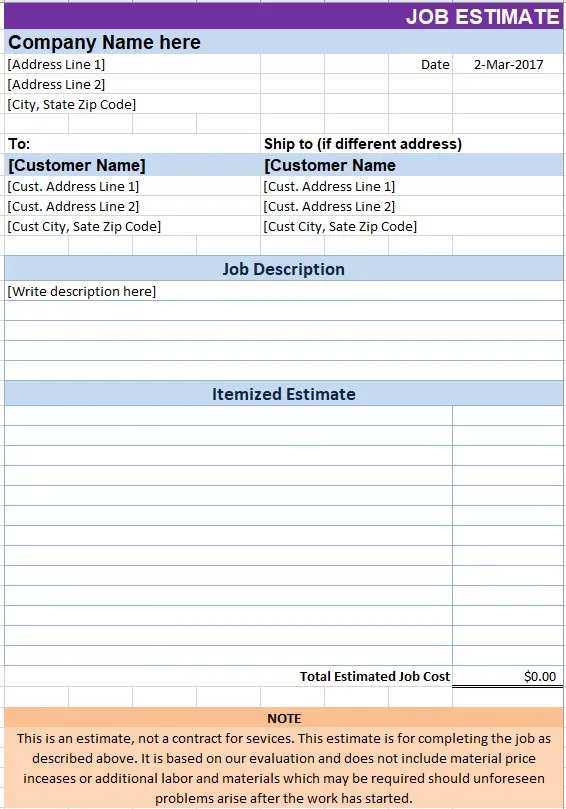
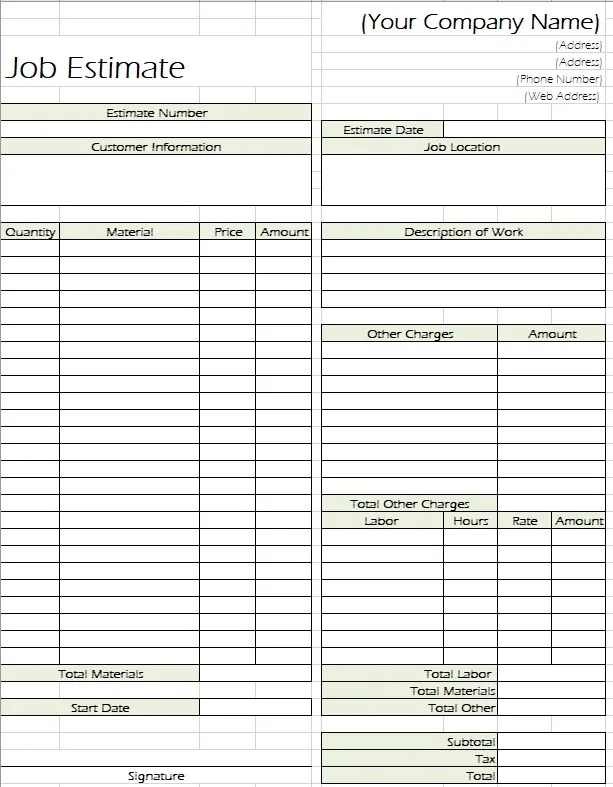
How does an estimate template differ from a formal contract?
An estimate template and a formal contract serve different purposes and have varying levels of legal binding. Below are some of the key differences:
Purpose:
- An estimate template generally provides a rough idea of a project’s cost, time, and scope.
- A formal contract outlines all parties’ obligations, responsibilities, and terms.
Legally Binding:
- An estimate is typically only legally binding if explicitly stated to be so.
- A contract is legally binding, and failure to meet the terms can result in repercussions.
Details and Specifications:
- Estimate templates usually offer a broad outline and may only include some of the minute details.
- Contracts typically have complete components, including payment terms, deadlines, quality of work, and penalties for non-compliance.
Flexibility:
- Estimates are more flexible and can be adjusted as the project progresses.
- Contracts are less flexible, and changes usually require formal amendments or addenda.
Signature:
- An estimate may or may not require signatures from the involved parties.
- A contract usually requires all parties’ signatures to be legally binding.
Time Sensitivity:
- Estimates often come with an expiration date, after which the terms may no longer be valid.
- Contracts generally specify the start and end date, and the terms are fixed for that period unless otherwise amended.
The Process of Filling Out an Estimate Template
Follow this guide for a straightforward experience.
Step 1: Download or Create the Template
- Select a Suitable Template: Choose an estimate template that fits your project. There are different types, such as Renovation, Flooring, or Auto Repair templates.
- Download: Once selected, download the template to your computer.
Step 2: Identify the Parties
- Client and Contractor Information: Insert the names, addresses, and contact information of both the client and contractor.
Step 3: Describe the Project
- Scope of Work: Clearly outline what the project entails. Be as specific as possible to avoid confusion later on.
Step 4: Set Timelines
- Start and End Dates: Define the project’s expected start and completion dates.
- Payment Dates: Specify when payments are expected, if applicable.
Step 5: List Costs and Materials
- Itemized Costs: Provide an itemized list of all costs associated with the project. It can include labor, materials, and other expenses.
Step 6: Include Exclusions
- What’s Not Covered: Clearly state any elements or services not included in the estimate.
Step 7: Add Certifications and Licenses
- Official Documents: Attach any necessary licenses or certifications, especially if the project requires specialized skills or compliance with regulations.
Step 8: Payment Terms
- Method and Terms: Specify the payment methods accepted and any payment schedule if relevant.
Step 9: Guarantees and Warranties
- What’s Guaranteed: Include any guarantees or warranties related to the service or materials provided.
Step 10: Finalize and Share the Estimate
- Review: Double-check the details for any errors or omissions.
- Signature Spaces: Provide space for both parties to sign, indicating their agreement with the estimated details.
- Share: Once both parties are satisfied, share the completed estimate and keep a copy for your records.
Conclusion
Free estimate template forms – Those are the short explanations of the estimate, the purpose of the estimate, the components of the form, when to use it, why to use it, free estimate template forms, the differences from a formal contract, and the process of filling out. It does not matter whether you and the contractor are a friend, this form exists to protect both of you.

The content creator team at calipsotree.com is dedicated to making topics accessible to everyone, with over 9 years of experience in writing and breaking down complex concepts into easy-to-understand articles that answer readers’ financial questions.








